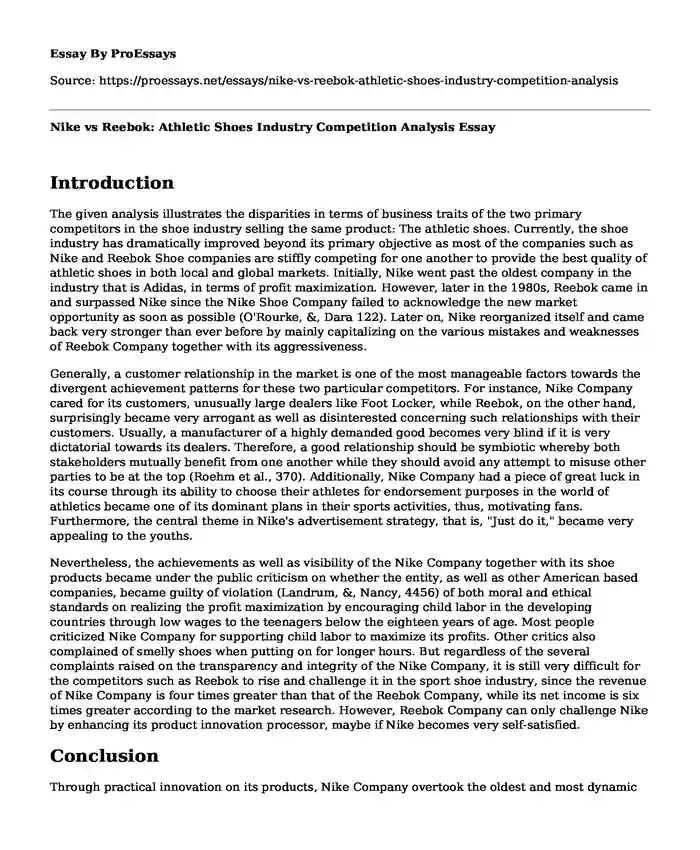Introduction
The given analysis illustrates the disparities in terms of business traits of the two primary competitors in the shoe industry selling the same product: The athletic shoes. Currently, the shoe industry has dramatically improved beyond its primary objective as most of the companies such as Nike and Reebok Shoe companies are stiffly competing for one another to provide the best quality of athletic shoes in both local and global markets. Initially, Nike went past the oldest company in the industry that is Adidas, in terms of profit maximization. However, later in the 1980s, Reebok came in and surpassed Nike since the Nike Shoe Company failed to acknowledge the new market opportunity as soon as possible (O'Rourke, &, Dara 122). Later on, Nike reorganized itself and came back very stronger than ever before by mainly capitalizing on the various mistakes and weaknesses of Reebok Company together with its aggressiveness.
Generally, a customer relationship in the market is one of the most manageable factors towards the divergent achievement patterns for these two particular competitors. For instance, Nike Company cared for its customers, unusually large dealers like Foot Locker, while Reebok, on the other hand, surprisingly became very arrogant as well as disinterested concerning such relationships with their customers. Usually, a manufacturer of a highly demanded good becomes very blind if it is very dictatorial towards its dealers. Therefore, a good relationship should be symbiotic whereby both stakeholders mutually benefit from one another while they should avoid any attempt to misuse other parties to be at the top (Roehm et al., 370). Additionally, Nike Company had a piece of great luck in its course through its ability to choose their athletes for endorsement purposes in the world of athletics became one of its dominant plans in their sports activities, thus, motivating fans. Furthermore, the central theme in Nike's advertisement strategy, that is, "Just do it," became very appealing to the youths.
Nevertheless, the achievements as well as visibility of the Nike Company together with its shoe products became under the public criticism on whether the entity, as well as other American based companies, became guilty of violation (Landrum, &, Nancy, 4456) of both moral and ethical standards on realizing the profit maximization by encouraging child labor in the developing countries through low wages to the teenagers below the eighteen years of age. Most people criticized Nike Company for supporting child labor to maximize its profits. Other critics also complained of smelly shoes when putting on for longer hours. But regardless of the several complaints raised on the transparency and integrity of the Nike Company, it is still very difficult for the competitors such as Reebok to rise and challenge it in the sport shoe industry, since the revenue of Nike Company is four times greater than that of the Reebok Company, while its net income is six times greater according to the market research. However, Reebok Company can only challenge Nike by enhancing its product innovation processor, maybe if Nike becomes very self-satisfied.
Conclusion
Through practical innovation on its products, Nike Company overtook the oldest and most dynamic shoe company, Adidas. Still, again, Nike faced stiff competition from Reebok since they underestimated the increased interest growth among the women in the aerobic dancing as well as other physical activities. Concerning the more massive Foot Locker, it is notable that to succeed in the computing environment, one has to prioritize customer satisfaction before any other factor. Nike Company prioritized the symbiotic relationship with its customers, which consequently led to considerable profit maximization, which made it surpass its competitors such as Reebok.
Works Cited
Donaghu, Michael T., and Richard Barff. "Nike just did it: International subcontracting and flexibility in athletic footwear production." Regional Studies 24.6 (1990): 537-552.
Fowler, Stephen J., and C. Hope. "Incorporating sustainable business practices into company strategy." Business strategy and Environment 16.1 (2007): 26-38.
Landrum, Nancy E. "A narrative analysis revealing strategic intent and posture." Qualitative Research in Organizations and Management: An International Journal 3.2 (2008): 127-145.
Landrum, Nancy Ellen. "A quantitative and qualitative examination of the dynamics of Nike and Reebok storytelling as a strategy." (2001): 4456-4456.
Mahdi, Hussain A. Ali, et al. "A Comparative Analysis of Strategies and Business Models of Nike, Inc. and Adidas Group with special reference to Competitive Advantage in the context of a Dynamic and Competitive Environment." International Journal of Business Management and Economic Research 6.3 (2015): 167-177.
O'Rourke, Dara. "Market movements: Nongovernmental organization strategies to influence global production and consumption." Journal of Industrial Ecology 9.12 (2005): 115-128.
Roehm, Michelle L., and Alice M. Tybout. "When will a brand scandal spillover, and how should competitors respond?." Journal of Marketing Research 43.3 (2006): 366-373.
Cite this page
Nike vs Reebok: Athletic Shoes Industry Competition Analysis. (2023, Feb 27). Retrieved from https://proessays.net/essays/nike-vs-reebok-athletic-shoes-industry-competition-analysis
If you are the original author of this essay and no longer wish to have it published on the ProEssays website, please click below to request its removal:
- Labor Disputes on Jet Airways
- Search Online for Products Essay Example
- How Visual Brand Identity Shapes Consumer Response Paper Example
- Essay Sample on Core Competency of Corporates
- Essay on Consumer Behaviour: Understanding Shopping Habits and Decision Making
- Organizations: Enhancing Cybersecurity With ML & AI - Annotated Bibliography
- Maximizing Human Resources for Success: The XYZ Company Story - Paper Example







